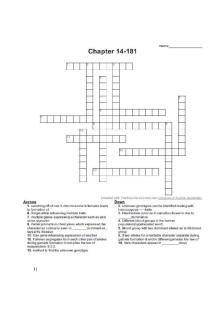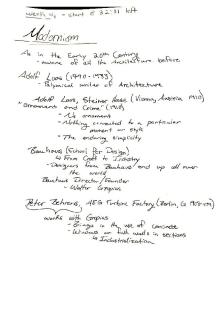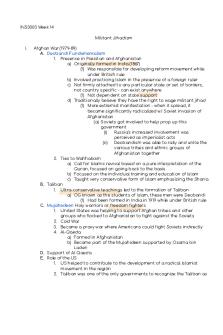WEEK 10-HW- Chapter 14 PDF

| Title | WEEK 10-HW- Chapter 14 |
|---|---|
| Course | General Biology I |
| Institution | Grand Canyon University |
| Pages | 7 |
| File Size | 412.5 KB |
| File Type | |
| Total Downloads | 15 |
| Total Views | 159 |
Summary
Download WEEK 10-HW- Chapter 14 PDF
Description
1)
2) 3) 4) 5) 6) 7) 8) 9) 10) 11) 12) 13)
Recessive Incomplete Multiple alleles Codominance Pleiotropy Polygenic Heterozygous Segregation Dihybrid cross Epistasis Assortment Testcross
Mendel’s Laws & Non-Mendelian Genetics Using the image given describe Mendel’s Law of Segregation. States that a diploid organism passes a randomly selected allele for a trait to its offspring, such that the offspring receives one allele from each parent.
Using the image given describe Mendel’s Law of Independent assortment. Mendel’s law of independent assortment says that the alleles of two (or more) different genes get sorted into gametes independently of one another.
1) Using the image given describe the difference between Complete Dominance, Incomplete Dominance and Codominance: Complete dominance is when the phenotypes of the heterozygote and dominant homozygote are indistinguishable. Codominance is when the phenotypes of both alleles are exhibited in the heterozygote because both alleles affect the phenotype in separate, distinguishable ways. Incomplete dominance is when the phenotype of heterozygotes is intermediate between the phenotypes of individuals homozygous for either allele.
2) Using the image given describe the difference Incomplete Dominance and Codominance. Complete dominance is when the phenotypes of the heterozygote and dominant homozygote are indistinguishable. Codominance is when the phenotypes of both alleles are exhibited in the heterozygote because both alleles affect the phenotype in separate, distinguishable ways. Incomplete dominance is when the phenotype of heterozygotes is intermediate between the phenotypes of individuals homozygous for either allele. PRACTICE: Monohybrid 1. Straight hair is dominant and curly hair is recessive. A. Diagram a Punnett Square for 2 heterozygous parents. B. What is the parents’ genotype(s)? Both parents are heterozygous (Hh) C. What is the parents’ phenotype(s)? Both parents have straight hair D. What is the genotypic ratio for the offspring? 1:2:1 E. What is the probability of producing a curly-haired child? (In percent) 25% 2. White-spotted beetles are dominant over solid colored beetles. A heterozygous male is crossed with a solid colored female. A. What is the mother’s genotype? Homozygous (ss) B. What is the father’s genotype? Heterozygous (Ss) C. Diagram a Punnett Square for this cross. D. What is the genotypic ratio? 1:1 E. What is the phenotypic ratio? 1:1 F. What is the probability of producing a spotted beetle? 50%
Chapter 14 Definition Review
Language of Genetics: Match the choices with the definitions below: a. alleles b. autosomes c. dominant d. genotype e. heterozygous f. homozygous g. phenotype h. recessive i. sex chromosomes j. wild type k. incomplete dominance l. codominance m. epistasis n. polygenic inheritance o. pedigree p. carriers ( d ) 1. Actual genetic makeup
( i ) 2. Chromosomes determining maleness/femaleness ( f ) 3. Situation in which an individual has identical alleles for a particular trait ( h ) 4. Genes not expressed unless they are present in homozygous condition ( g ) 5. Expression of a genetic trait ( e ) 6. situation in which an individual has different alleles making up the genotype for a particular trait ( a ) 7. Genes for the same trait that may have different expressions ( b ) 8. Chromosomes regulating most body characteristics ( c ) 9. The more potent gene allele; masks the expression of less potent allele ( l ) 10. Two dominant alleles affect the phenotype in two different ways ( o ) 11. A chart that tracks the inheritance of certain traits ( j ) 12. The phenotype most often encountered in nature ( n ) 13. A phenotype that results from the additive effect of two or more genes ( k ) 14. The phenotype of the offspring is somewhere in between the phenotypes of the parents ( p ) 15. A heterozygote who shows a normal phenotype ( m ) 16. A gene at one locus will change the phenotypic expression of a gene at another locus A monohybrid cross is a cross between 2 individuals that differ by 1 trait, and the phenotypic ratio would be 1:2:1. A dihybrid cross is a cross between two different lines/genes that differ in two observed traits, and the phenotypic ratio would be 9:3:3:1.
TERMS YOU WANT TO BE FAMILIAR WITH Distinguish Mutant vs wild-type Wild type is the phenotype most commonly observed in natural populations; also refers to the individual with that phenotype. Mutant is a change in the nucleotide sequence of an organism’s DNA or in the DNA or RNA of a virus. F1 offspring vs F2 F1 is offspring arising from a parental (P generation) cross. F2 is the offspring resulting from interbreeding (or self-pollination) of the hybrid F1 generation. List the Characteristics of organisms useful for genetic studies Developing to maturity rapidly, the ability to be easily manipulated, having a short life span, and producing many offspring. What is the difference between Genotype and phenotype? Genotype is the set of genes inherited from parents and phenotype is the physical appearance.
What is the difference between Homozygous and heterozygous? Homozygous is having two identical alleles for a given gene and heterozygous is having two different alleles. What is the difference between and hemizygous? Hemizygous is a condition in which only one copy of a gene or DNA sequence is present in diploid cells. What is a Test cross and why is this useful? A testcross is breeding an organism of unknown genotype with a homozygous recessive individual to determine the unknown genotype. It is useful because the ratio of phenotypes in the offspring reveals the unknown genotype. Compare a Mutant vs wild type Wild type is the phenotype most commonly observed in natural populations; also refers to the individual with that phenotype. Mutant is a change in the nucleotide sequence of an organism’s DNA or in the DNA or RNA of a virus. List some of the True-breeding characters identified by Mendel It undergoes self-pollination. It depicts stability in the inheritance for several generations. Provide gametes with similar traits, hence used as parents for artificial hybridization. Homozygous recessive plants are used to identify the genotype through a test cross. How many unique gametes can be produced from a cross? 32 What are the laws proposed by Mendel? Law of Dominance, law of Segregation, and law of Independent Assortment. Explain: Mendel’s law of segregation and law of independent assortment Law of segregation: When an organism makes gametes, each gamete receives just one gene copy, which is selected randomly. Law of independent assortment: allele pairs separate independently during gametes formation. What are the different types of crosses and expected ratios? Monohybrid and dihybrid crosses Phenotypic and genotypic ratios of monohybrid and dihybrid crosses Description
Example
Complete Dominance
When the phenotypes of the heterozygote and dominant homozygote are indistinguishable.
Brown eyes
Incomplete
When the phenotype of
When one parent with straight hair and one
Dominance
heterozygotes is intermediate between the phenotypes of individuals homozygous for either allele.
with curly hair have a child with wavy hair
Codominance
When the phenotypes of both alleles are exhibited in the heterozygote because both alleles affect the phenotype in separate, distinguishable ways.
AB blood type
Epistasis
A type of gene interaction in which the phenotypic expression of one gene alters that of another independently inherited gene.
A gene for total baldness would be epistatic to one for blond hair or red hair.
Pleiotropy
The ability of a single gene to have multiple effects.
Phenylketonuria
Polygenic Inheritance
An additive effect of two or more genes on a single phenotypic character.
Skin color
Descriptions of P, F1 and F2 generations P generations is the true-breeding (homozygous) parent individuals from which F1 hybrid offspring are derived in studies of inheritance. F1 is offspring arising from a parental (P generation) cross. F2 is the offspring resulting from interbreeding (or self-pollination) of the hybrid F1 generation.
Simple Punnett square crosses with ratios and probabilities Problems
1. In cats, long hair is recessive to short hair. A true-breeding (homozygous) short-haired male is mated to a long-haired female. What will their kittens look like? All the kittens will have short hair. 2. Two cats are mated. One of the parent cats is long-haired (recessive allele). The litter which results contains two short-haired and three long-haired kittens. What does the second parent look like, and what is its genotype? The second parent has short hair but is heterozygous carrying the recessive gene. 3. In cats, long hair is recessive to short hair. A true-breeding (homozygous) short-haired male is mated to a long-haired female. What will their kittens look like? All the kitten will have short hair.
4. Two cats are mated. One of the parent cats is long-haired (recessive allele). The litter which results contains two short-haired and three long-haired kittens. What does the second parent look like, and what is its genotype? The second parent has short hair but is heterozygous carrying the recessive gene....
Similar Free PDFs

WEEK 10-HW- Chapter 14
- 7 Pages

MKT NOTE WEEK 11- Chapter 14
- 2 Pages

Week 14 Lab Worksheet
- 2 Pages

Week 14 GST - GST
- 4 Pages

Disease Processes Week 14
- 6 Pages

Week 14 Assignment
- 3 Pages

Week 14 Notes
- 9 Pages

TASK WEEK 14
- 3 Pages

INS3003 Week 14 Notes
- 5 Pages

Zoo biology week 14
- 5 Pages

Week 14 Reading Response
- 1 Pages

Week 14 Lab Worksheet
- 2 Pages

Chapter 14 - Lecture notes 14
- 5 Pages

Chapter 14
- 13 Pages

Chapter 14
- 46 Pages

Chapter 14
- 20 Pages
Popular Institutions
- Tinajero National High School - Annex
- Politeknik Caltex Riau
- Yokohama City University
- SGT University
- University of Al-Qadisiyah
- Divine Word College of Vigan
- Techniek College Rotterdam
- Universidade de Santiago
- Universiti Teknologi MARA Cawangan Johor Kampus Pasir Gudang
- Poltekkes Kemenkes Yogyakarta
- Baguio City National High School
- Colegio san marcos
- preparatoria uno
- Centro de Bachillerato Tecnológico Industrial y de Servicios No. 107
- Dalian Maritime University
- Quang Trung Secondary School
- Colegio Tecnológico en Informática
- Corporación Regional de Educación Superior
- Grupo CEDVA
- Dar Al Uloom University
- Centro de Estudios Preuniversitarios de la Universidad Nacional de Ingeniería
- 上智大学
- Aakash International School, Nuna Majara
- San Felipe Neri Catholic School
- Kang Chiao International School - New Taipei City
- Misamis Occidental National High School
- Institución Educativa Escuela Normal Juan Ladrilleros
- Kolehiyo ng Pantukan
- Batanes State College
- Instituto Continental
- Sekolah Menengah Kejuruan Kesehatan Kaltara (Tarakan)
- Colegio de La Inmaculada Concepcion - Cebu